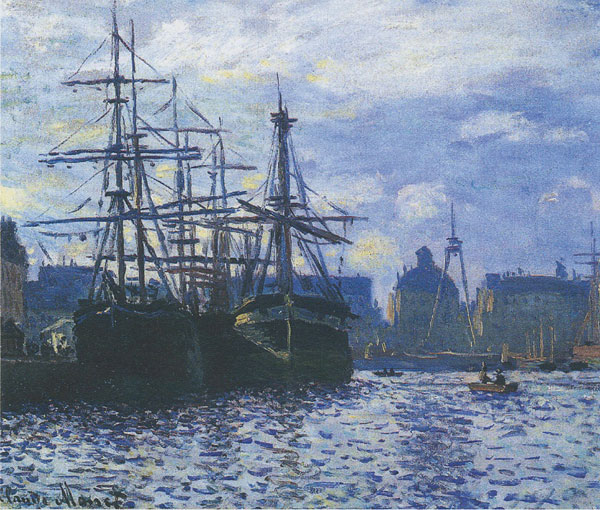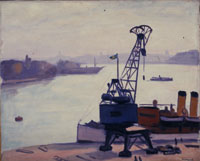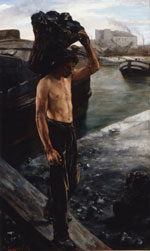The exhibition of nearly 160 works (including 48 photographs) on the theme of the iconography of ports has a perfect setting in the Havre. Indeed Le Havre is one of those large cities whose image has been forged on a strong port identity. All of the collections of its museum are the cultural reflection of economic activities linked to the port. In 1903, the City – encouraged by major art amateurs- bought from Camille Pissarro two views of the port of Le Havre he had just painted during a stay in the Norman port. It thus became the first French municipality to include in a public collection a work by this artist, on the eve of his demise. Two important private collections entered the town’s funds in 1936 and 2004, those of the important merchants in the city, Charles-Auguste Marande and Olivier Senn.
The port, a living organism
The representation of the port was idealized for a long time in Claude Lorrain’s classic tradition, and hardly evolved between the XVII th and XVIII th centuries. The economic development of the XIXth century brought about deep changes in the port world and, with the progressive disappearance of sail ships, large modernisation sites were launched.
As the navy with sails disappeared the vision of the artists changed. The port ceased being a metaphoric site of traveling, to become a living world, bustling with activity, a place full with smells and movements, a territory charged with sound and noise which states its autonomy. Artists that were sensitive to modern life found there the reflection of their time disrupted by industrialization. Their eyes then swept over a new landscape emphasized by metal silhouettes of transporter bridges, steam cranes. In their compositions they embrace the expanded spaces of the docks where the number of warehouses has multiplied. Some artists, more aware of the human elements, describe without kindness the exhausting work of the dockers moving among the ropes, the gangways and railroad tracks.
Signac, Marquet, Meunier, Lhote…
The exhibition shows the change in the representation of that universe, from the 1850s until the eve of WW II. The incursions of the pointillist painters are presented through the work of Maximilien Luce and Paul Signac, who undertook towards the end of his life an ambitious series of watercolors, «Les Ports de France», for collector Gaston Lévy. Albert Marquet is by far the great painter of the ports of the XXth century. A significant ensemble of paintings depicts the diversity of the sites the artist traveled to, from Bordeaux, his native town, to Marseille and Stockholm. Special attention is given to the artists from Northern Europe who, influenced by realism and naturalism, questioned the colorful world of the Dutch or Belgian docks: dockers by Constantin Meunier, somber and melancholic visions by Van Mieghem. Cubism makes its own the new port territories structured by lines of force that render the landscape geometrical. Artists such as André Lhote find the perfect excuse for new visual explorations.
Illustration : Albert Marquet, Stockholm, la grue, 1938, huile sur toile, Bordeaux, musée des Beaux-Arts, ADAGP
The transporter bridge, a photographic icon
Like painting or literature, photography draws a specific imaginary world. The port includes the «quotient » of modernity it is entitled to due to its double role – functionality and picturesque. Through the monumentalization of the works the various views of boat constructions and structures encourage the celebration of progress. At the turn of the XXth century, pictorialism replaced the clarity of the technical documents by images saturated with atmosphere, as can be seen in the views of Hamburg by Schmidt and Kofahl (1908), in the review Camera Work, the organ of Photo-Sécession, directed by Stieglitz, or among the French artists Lhermitte, Demachy and Puyo. At the eve of the 1920s, the port became a laboratory of the avant-guard vision built with high angle and low angle shots, with shots take out of balance and perspectives. This «expressionism» of vision hunted down breathtaking architectures, in particular through the motive of the transporter bridge, treated by Lazlo Moholy Nagy, Germaine Krull, Man Ray or
François Kollar.
Illustration : Henri Gervex, Etude pour Le Quai de la Villette à Paris, 1882, huile sur toile, Lille, Palais des Beaux-Arts, © RMN / © René-Gabriel Ojéda
PUBLICATION:
Catalogue published by Somogy publishing house: 264 p., 220 color illustrations, 29 €.
|










